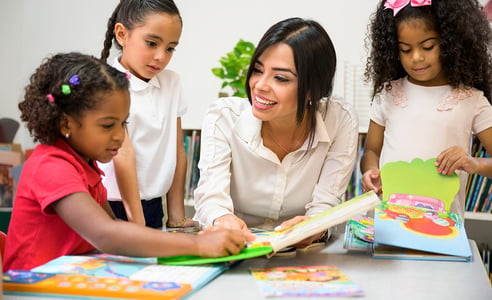
Every year in the U.S., the amount of young children who live in a household where a language other than English is spoken has been steadily increasing. As of 2016, about one-third of children under age 8 – over 11 million children – are dual language learners (DLLs).
DLLs in Early Childhood
This growing diversity presents an incredible opportunity for early childhood educators. Bilingual and multilingual students are constantly exercising their executive function skills. This code-switching is positively associated with academic achievement. Students who are exposed to more than one language and culture learn from an early age to analyze different perspectives, building empathy and developing cultural competency.
However, many early childhood educators feel like they still need to learn how best to help students develop in both languages. Even though, on average, young DLLs ultimately catch up - and surpass - their monolingual peers’ academic achievement, there is more and more pressure to think about kindergarten readiness. Helping teachers learn skills to help students develop proficiency in home and in target languages is an important long-term goal. But what can you try in your classroom this week to help DLL students?
1. Make explicit connections
This is one of the core principles of Concept Development. Teachers who understand Concept Development well are able to link concepts and activities to one another and to previous learning. That is also what effective language acquisition teachers do! You can do this with words in a student’s home language, in English, or both.
For example, when reading A Chair for My Mother by Vera Williams, you might ask questions about times when children have saved money, lost a treasured item, or gone to the store with their families. Point to images in the book as you read out key words, like “jar,” “armchair,” and “flames.” Refer back to the story and those words during centers or through group activities – “Remember when Rosa and her family saved their coins for an armchair? How do you think we could save for a class pet?” or, “You built a fire station – that’s where the firetrucks are that put out the flames, like in the book.”
Language acquisition teachers consistently make connections between concepts and students’ actual lives and try to provide hands-on opportunities for students to internalize and make language learning meaningful.
2. Give students different ways to show their knowledge
Effective language acquisition teachers consistently provide scaffolding to students who are having a hard time understanding a concept or question.
Teachers don’t always need to rely on spoken language. It may work better to use visuals and props. Offer students the opportunity to demonstrate their understanding of a concept by keying in to their non-verbal cues, drawing an answer, or using materials to make their thinking visible. Just because a student is still developing their expressive language in the target language, it doesn’t mean they’re unable to reflect and explain their thinking. It just looks different than the typical back-and-forth verbal exchange we might expect in a feedback loop.
By using all of the available modalities and really focusing on what children can demonstrate, not just say, you can increase their persistence, help them grow, and see what they’re able to do.
3. Lots and lots of purposeful talking (and listening)
Regardless of what stage of language learning a student is in, effective language acquisition teachers are modeling language all the time! This constant exposure helps students become fully bilingual and biliterate. Teachers can do this through self- and parallel-talk, describing what they are doing and what they see in the classroom.
But you won’t be the only one talking! Even with a target language in which students can only produce a limited number of words, you can and should have conversations. Give DLL students enough time to organize their thoughts and practice the target language in low-stakes, smaller settings by using strategies like think-pair-share. In these and other conversations, repeat, repeat, repeat! In your response, add words in the target language. Make it clear to students that it’s okay to use both their home language and the target language to explain their thinking. It’s fine, and even beneficial, for students to use their full language repertoire.
The strategies above are starting points for learning more about the individual needs of your students and best practices for dual language learners. By making explicit, relatable connections, finding ways to meet students where they are, and thoughtfully getting children talking, you’re helping all of your students. In fact, research has shown that high-quality interactions, as measured by CLASS, have similar effects for monolingual and DLL students.
So this week, celebrate your brilliant, bilingual students, try these strategies, and make a plan to learn more.
What strategies have you used to support dual language learners? Share them in our CLASS Learning Community on Facebook. We also have a CLASS community for Spanish speakers, La Comunidad de CLASS.
Authors
Allie Kallmann holds a Master’s degree in education policy from Teachers College, Columbia University. She is a former Head Start educator and CLASS data collector. She now works in early childhood professional development and research in Arkansas. Allie firmly believes that ensuring all young children have access to life-changing, relationship-building educators is critical to ensuring our more equitable future.
Paloma Panesi, M.Ed. is a Teachstone Regional Director. She is a bilingual educator with over 15 years of experience in the field of early childhood. She served as early years assistant principal at Washington International School (WIS). Prior to that, she worked for DC Public Schools in a variety of roles, including bilingual instructional coach and dual language early childhood administrator. Paloma is a native Spanish speaker and a former Pre-K certified CLASS observer. She holds an M.Ed. in curriculum and instruction from Trinity University and a BA in Latin American studies from American University.

